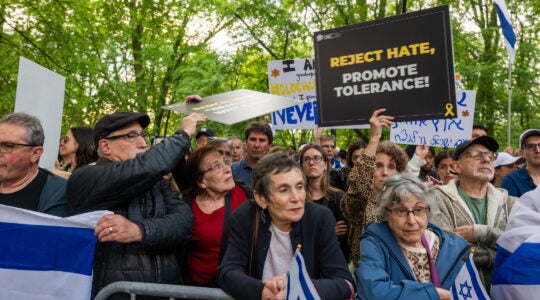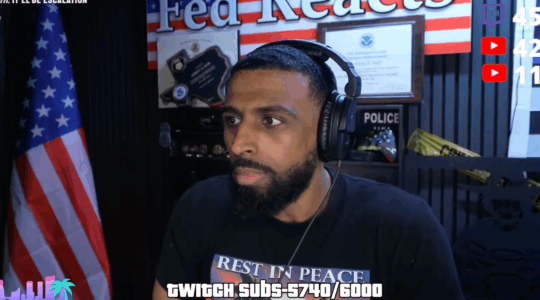COSTA MESA, Calif. (JTA) – It was the Karlin-Stoliner rabbis in the Havdalah congo line that had everyone buzzing.
Sure, there were great workshops, spirited davening, morning yoga and late-night shmoozing, and all the other multigenerational, multidenominational, plura-palooza that Jews in the know have come to expect from the Jewish learning extravaganza known as Limmud, which made its Los Angeles debut this past weekend.
But of the dozens of sessions that took place over three days – from a midnight screening of the low-budget Chasidic zombie movie “Night of the Living Jews” to Deborah Lipstadt’s Sunday morning talk on Holocaust denial – what stuck in the minds of many of the 650 participants was the two Chasidic guys in their long black coats and fur shtreimels.
There they were Saturday night, marking the end of Shabbat with hundreds of other men, women and children in a raucous outdoor celebration, complete with drumming, dancing and top-of-the-lungs singing next to the parking lot of the Costa Mesa Hilton.
“I knew what I was getting into and I still wanted to come, because I love all Jews,” said Rabbi Moshe Shapoff, who traveled to Limmud LA from his Israeli home in the Jerusalem suburb of Givat Zeev, where he co-founded a vocational school for haredi youth.
“I was literally in tears seeing all those Jews dancing together. At the end of the day, it’s not what we wear, but that one soul touches another,” he said.
That’s a big part of what the British-based, volunteer-driven Limmud is about: Jews of all stripes and ages coming together to study, worship and learn from each other.
Although world-class rabbis, scholars and literary figures show up to lead sessions, they don’t get paid, and they’re expected to stick around and learn with everyone else. People pick and choose from dozens or hundreds of offerings, sharing ideas that span the denominational and the political spectrum.
Where else would one see yarmulke-wearing grandfathers and teens with pierced eyebrows enjoying the same midnight concert of New Jewish music?
Limmud is a grassroots, intensive Jewish experience that has tapped into something profound and timely in the global Jewish community. And it seems to have happened by accident.
The first Limmud was put together 27 years ago by a group of British Jewish educators for an intensive week of study and professional development.
Today, Limmud in the United Kingdom is a hugely popular undertaking, no longer limited to Jewish professionals: Some 600 presenters and 2,500 participants showed up last December for the 28th annual event.
From England the model is spreading quickly throughout the Jewish world. The first export was in 1999 to Australia. Holland followed next, then Toronto, Paris, New York, Lithuania, Hungary.
In the past two years, the number has more than doubled, as Russia, Germany, South Africa, Israel, Bulgaria and Serbia got on board. This year, new Limmuds will take place in Ashkelon, Israel; Buenos Aires, Argentina; Yalta, Ukraine; and Khabarovsk, Russia.
Altogether around the world, Limmud has reached more than 30 communities.
In the United States, Limmuds are scheduled this year for Denver and Atlanta, and planning committees have organized in Philadelphia and Chicago.
“There’s been a huge response,” says Andrew Gilbert, chair of Limmud International, the arm of Limmud in Britain responsible for spreading the model. “L.A. sold out, the Baltics sold out, the demand is remarkable. And it’s all coming from the people, the volunteers who are running things.”
Gordon Erick, a 31-year-old writer-producer in Los Angeles, likes the fact that Limmud isn’t organized by what he calls “the usual suspects” of the Jewish world.
“I haven’t heard a word about Michael Steinhardt all weekend,” he says, referring to the mega-philanthropist who was one of the original funders of birthright israel, another Jewish program hailed for being innovative and unusual. “What makes this so engaging to me is that it’s outside the usual arms of influence.”
Still, Erick acknowledges a debt owed to establishment leaders he’s glad not to see.
“This wouldn’t have happened without Michael Steinhardt and those others in the ‘90s putting all that money into my generation,” he says. “I give them a lot of credit. This is what they were trying to do: light a fire, so our generation would take it up.”
Limmud spreads by word of mouth. People come to one Limmud, get energized and go home to organize one of their own.
Limmud New York started three years ago, created by people who had been to Limmud UK. And now New York has spawned other Limmuds, from the Los Angeles event last weekend to Colorado, planned for May 23-26 at a mountain resort between Denver and Boulder, and Georgia, scheduled for March 1-2 at Atlanta’s Oglethorpe University.
Eric Robbins of Atlanta went to the first Limmud New York in January 2005, and “found it exhilarating.” The following year he brought four friends, including Jodi Mansbach, who serves with him on the board of Jewish Arts and Culture, an Atlanta organization that sponsors salons and cultural programs aimed at younger Jews.
The two are now co-chairs of Limmud Atlanta Southeast, which Jewish Arts and Culture has taken on as a project.
The organizing meeting was held in Mansbach’s living room. Two dozen volunteers came together over a six-month period, they raised $50,000, rented space at a local university and now are waiting for the magic to happen.
“We have 70 sessions, and expect 300 to 500 people,” Robbins says.
“In some ways, New York has less of a need for Limmud,” he says, referring to that city’s large Jewish population and myriad opportunities for involvement. “In Atlanta we have a great Jewish film festival, great arts programs, some dynamic educators, but no event where you can find them all together.”
Robbins ticks off the planned highlights of Atlanta’s first Limmud: Havdalah, a play, classes led by Orthodox rabbis and a rabbi of a local gay and lesbian synagogue, a session on life in a West Bank settlement as well as one on Israel’s pressing environmental concerns. There will be a separate teen track, and buses for those taking part in Atlanta’s annual Hunger Walk.
“This event, which is very grassroots, put on by volunteers, is a celebration of all Atlanta has become Jewishly, and that’s what’s so exciting,” Robbins says.
Most Limmuds hire one part-time executive director, the only paid position. The hardest part of getting a new Limmud off the ground, those involved say, is persuading people to volunteer for something they have not yet experienced.
“We walk a tightrope between the traditional Jewish community way of saying, ‘Let’s just do it ourselves,’ and following the Limmud model of getting volunteers to own it and share it,” says Beth Steinhorn, executive director of Limmud Colorado.
Empowering people who are not Jewish professionals to run this large-scale Jewish communal event is integral to the Limmud concept, says Gilbert of Limmud International, as it gives people a stake in their own Jewish development.
That’s particularly appealing to the under-40 set, he says, who comprise the bulk of Limmud volunteer organizers as well as participants.
“This is a culture of allowing people to go ahead and organize themselves, a bit like the open-source IT community as against Apple and Microsoft. It uses all the methodologies of social networking, of Facebook and MySpace.”
If Gilbert’s enthusiasm can be a bit overwhelming – he posits Limmud as a new organizational matrix for Jewish communities around the world – there are others who are turned into true believers by a weekend at Limmud.
Coming into such close contact with Jews they never would have known otherwise gives some participants a sense of Jewish communal purpose and individual belonging they didn’t have before.
Jessica Kendler, 26, is a program associate for Hillel at the University of Florida in Gainesville. She volunteered for Limmud LA because, she says, “I always have a better experience when I’m involved. The second you get involved, you claim the experience as your own.”
Peggy Parskey, who was interviewing participants of Limmud LA for a commissioned survey, says she has found that “people are very excited about the diversity, that there are opportunities to be in the same space with people of different denominations.”
“One Orthodox woman said she’s always thought Orthodox were the only religious ones, and to see secular Jews so excited about Havdalah was amazing to her,” Parskey says.
Although organizers of every Limmud formally pledge to uphold a list of principles set down by the founding Limmud UK – thou shalt not make a profit, thou shalt not look askance at those unlike thyself – there are geographic differences.
Limmud LA, for example, had a strong Orthodox showing, including numerous families with small children. Limmud UK, on the other hand, is under a formal boycott by Britain’s Orthodox establishment, which organizers hope has ended with the recent death of the rabbi behind the boycott.
But unlike their British counterparts, many Orthodox Jews in Los Angeles are used to coexisting with the non-observant.
“At Limmud in Britain, no one would carry a cell phone on Shabbat,” says Mitchell Griver, 46, a longtime Limmud UK volunteer who came to Limmud LA. “And you wouldn’t see Ferraris and Porsches in the parking lot.”
It might be nice to take some of that diversity back home, he says.
“If we continue to divide, it will threaten the whole Jewish people. If that means accepting people’s differences,” Griver says, “so be it.”
JTA has documented Jewish history in real-time for over a century. Keep our journalism strong by joining us in supporting independent, award-winning reporting.





